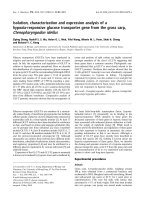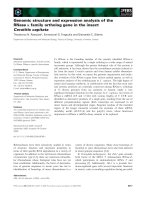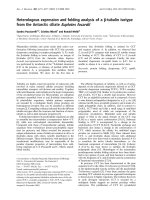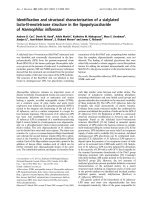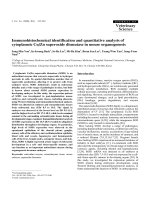Identification and sequence analysis of a DREB subfamily transcription factor involved in drought stress tolerance from rice
Bạn đang xem bản rút gọn của tài liệu. Xem và tải ngay bản đầy đủ của tài liệu tại đây (1.25 MB, 8 trang )
31(4): 74-81
T¹p chÝ Sinh häc
12-2009
Identification and Sequence analysis of a DREB
subfamily transcription factor involved
in drought stress tolerance from rice
Xuan Hoi Pham, Tuan Tu Tran
The Institute of Agricultural Genetics, Hanoi
Abstract: DRE (dehydration responsive element)/CRT (C-repeat) is a cis-acting element that involves
in gene expression responsive to abiotic stress in higher plants. To date, all well known DREBP
transcription factors in Arabidopsis, rice, maize and other plants regulate gene expression in response to
drought, high-salt and cold stresses by binding specifically to DRE/CRT. Using a target sequence of 50
nucleotides on Glutamate dehydrogenase-like protein (JRC2606) promoter containing the core sequence of
DRE cis-acting element (A/GCCGAC) for yeast one-hybrid screening, we have identified two transcription
factors: a completely homology of OsRAP2.4A gene and another is a new sequence. The new sequence
contained an ORF (Open Reading Frame) of 1017-bp and 5’ non-coding area of 35-bp and 3’ non-coding
area of 341-bp. The deduced amino acid sequence contains an AP2 domain and belongs to the subgroup
A6 of DREB subfamily, temporarily named OsRAP2.4B. Sequence alignment showed that OsRap2.4B had
homology with ZmDBF, a maize transcription factor involved in drought stress tolerance.
Keywords: Transcription factor, DRE/CTR, OsRap2.4B, drought stress tolerance.
Plants are not mobile and thus must respond
and adapt to abiotic stress such as drought, high
salt, heat, cold in order to survive. Under these
stresses, plants induce various biochemical and
physiological changes in process of acquiring
stress tolerance. Discovering of numerous genes
responsible for stress tolerance suggests that
many of them are transcription factors [16].
Among these transcription factors is an
ERFBP/AP2 family has been identified in a
variety of higher plants. Significantly, the
introduction of many stress-inducible genes via
gene transfer resulted in improved plant stress
tolerance [16, 17, 19]. In Arabidopsis, this
family consists of 145 distinct genes encoding
ERFBP/AP2 protein and can be divided into
three subgroups based on the number of
ERFBP/AP2 domains in each molecule. The
AP2 subgroup includes 14 genes, each encodes
a protein containing two ERFBP/AP2 domains.
The RAV subgroup includes six genes that
conserve two different DNA-binding domains,
ERFBP/AP2 and B3. The ERFBP subgroup
includes 125 genes, each encodes a protein with
only one ERFBP/AP2 domain. Of these, 121
genes contain a conserve WLG motif in the
middle of their ERFBP/AP2 domain [15]. The
74
members of the ERFBP subgroup can be further
divided into two subfamilies: DREB subfamily
and DREB-like protein subfamily, based on the
similarity of the amino acid sequence of the
DNA-binding domain. DREB subfamily
consists of 56 genes in Arabidopsis genome and
all of them contain one ERFBP/AP2 domain
considered to play a crucial role in the process
of the response to environmental stresses. DREB
subfamily is divided into 6 small groups based
on similarities of the binding domain. The first
and second small groups (A1, A2) include of
DREB1/CBF and DREB2 gene families,
respectively. The third small group (A3) has
only ABI4. The fourth small group (A4)
contains 16 genes, including TINY. The fifth
small group (A5) consists of 16 genes, including
RAP2.1, RAP2.9 and RAP2.10. The sixth small
group (A6) consists of nine genes, including
RAP2.4 [15].
DREB subfamily specifically recognizes and
binds to the dehydration responsive element
(DRE) or DRE-like cis-element. The core
sequence of the DRE is A/GCCGAC that exists
frequently in promoters of plant genes induced
by dehydration, high salt, heat and cold stresses
[18]. Both DRE-like cis-elements, named C-
repeat (CRT) and low-temperature-responsive
element (LTRE) contained a CCGAC core motif
also reported to regulate low-temperature
inducible promoters [1, 9].
DREB subfamily so far includes DREB1AC (CBF1-3), DREB2A-B, three novel DREB1s
and six novel DREB2-related genes in
Arabidopsis genome have been isolated, and
their corresponding gene products showed
significant sequence similarity to the conserved
DNA-binding domain found in ERFBP/AP2
proteins [8, 11, 15]. Expression of the
DREB1/CBF genes induced by cold stress and
their gene products activate the expression of
more than 40 genes in the DREB1/CBF region
and resulted in an improved tolerance not only
to freezing but also to drought and high salinity
[3]. DREB1/CBF orthologs have been reported
and shown to functional in cold stress tolerance
from various species, including Brassica napus,
tomato, barley, maize, rice, and wheat [2, 4-7,
13]. In contrast, expression of the DREB2
genes induced by dehydration or high salt stress
rather than cold stress. Overexpression of
DREB2A in transgenic plants does not activate
downstream genes under normal growth
condition suggesting that post-translational
regulation may be involved in its activation [11].
Recently, a negative regulatory domain
identified in central region of DREB2A and
deletion of this region transforms DREB2A to a
constitutive
active
form,
DREB2ACA.
Transgenic
Arabidopsis
overexpression
DREB2ACA showed increased expression of
many stress inducible genes and resulted in an
improved tolerance to drought stress [14]. A
number of efforts have been focused on
characterization of drought and high-salt stress
transcription factors in different plants including
rice, wheat, barley and maize [2, 13]. However,
function of these genes under drought condition
is not much clear, except ZmDREB2A that is
accumulated by cold, dehydration, salinity and
heat stresses. Unlike DREB2A, ZmDREB2A
produced two forms of transcripts but only
functional transcription form of ZmDREB2A
significantly induced by stresses suggesting that
protein modification is not necessary for
ZmDREB2A function. Transgenic plants
overexpressing ZmDREB2A resulted in up
regulation expression of a number of drought
inducible genes including late embryogenesis
abundant (LEA), heat shock and detoxification
proteins. Constitutive or stress-inducible
expression of ZmDREB2A resulted in an
improved drought stress tolerance in plant [13].
I. Materials and Methods
1. Plant materials and stress treatments
An Indica rice variety namely cultivar Moc
tuyen was grown in controlled conditions in
incubator at 30 ± 1oC and 12 h photoperiod. The
seeds were first soaked in water at room
temperature overnight and surface sterilized by
bovastin powder for 15 min and after that kept
under following water for half an hour. To
germinate, seeds kept on autoclaved germination
paper (at a distance app. 1cm between seeds),
rolled and kept into beaker. Half strength MS
basal medium (liquid) supplied after seeds
germinated. After ten days, drought treatments
given by putting them into 20% PEG solution for
1, 4, 8 and 24 h; all of them were collected
separately put in liquid nitrogen and stored at 80oC till the further use.
2. Construction of stress cDNA library
Total RNA extracted from 15-day-old rice
using GITC buffer standard protocol. The
mRNA was purified from total RNA by
magnetic separation after annealing with
biotinylated oligo-dT primer and immobilizing
it onto streptavidin-linked paramagnetic beads.
cDNA Library was constructed from 5 µg of
mRNA in Hybrid Zap 2.1 vector by following
manufacturer’s (Stratagene) protocol using
HybriZAP-cDNA
library
Synthesis
Kit
(HybriZAP®-2.1 XR Library construction kit
and HybriZAP®-2.1 XR cDNA synthesis kit,
/>The resulting cDNA was unidirectional
subcloned into EcoRI and XhoI sites within the
MCS region in the phage vector, and packaged
by Gigapack III Gold packaging extract. After
amplification primary library according
manufacturer’s protocol, phage library were
aliquot into eppendorf tubes and stored at -80oC
for long time. The titer of the cDNA library is
estimate around 1010 pfu/ml after amplifying
(data not show). After that, pAD-GAL4 2.1
75
vector was excised from the Hybrid Zap 2.1
vector according to mass in vivo excision
protocol from Stratagene (data not shown).
3. Construction of reporter plasmids for
yeast one-hybrid screening
We have selected target sequences contain
DRE sequences from a promoter sequence of a
cold stress-inducible gene encoding glutamate
dehydrogenase-like protein (JRC2606). Specific
target sequence is AGCCAAACGCAGCCG
GCCGACCTCCTCCCGTGCCTTCCTCCTCGA
TCCCC. The pHISi-1 and pLacZi vectors are
employed for constructing target-reporter
constructs.
4. Yeast one-hybrid screening
drought cDNA library
of
rice
Dual reporters of pHISi-1 and pLacZi
containing four tandem copies of target
sequences were linearized by XhoI and NcoI
respectively, then transformed into Yeast
genome (YM4271, Clontech) to form parental
yeast containing both reporters. Yeast onehybrid screening of rice drought cDNA library
was carried out as manual protocol of yeast one
hybrid screening (Clontech). These clones were
isolate with yeast DNA isolation protocol of
Clontech. pAD-GAL4 plasmids containing
cDNA inserts were isolated from the positive
clones. After that cDNA were excised with
EcoRI from pAD-GAL4 plasmid and then
ligated into pSK II vector for sequencing.
II. Results
1. Isolation of cDNA encoding DNA binding
proteins that interact with DRE in the 50bp DNA fragment of JRC2606 promoter
A
B
Figure 1. Design and construction of target sequence
Electrophoresis PCR produce with specific primer T7/T3 show that lane 7 and 8 are emty vector; lane 3 and 4
are vector containing a insert DNA including 2 tandem repeated target sequences. Similarry lane 6, lane 9/10
are the PCR produce of a vector containing 4 and 6 tandem repeated target sequence, respectively. The clone
sixth was chosen for isolating plasmids and sequencing. The result also comfirm that this clone containing a
vector with 4 tandem repeated target sequence be beatwen Sma I and EcoR I sitr in the MCS region.
To isolate cDNA encoding DNA binding
proteins that interact with DRE motif, we have
used yeast one-hybrid screening system. The
first, we synthesized three pair of antiparallel
oligo-nucleotides of the target sequence. In each
pair, one strand represents the sense and the
other its antisense complement. The sense
strand of first pair of antiparallel oligonucleotides containing EcoRI site in 5’ end
anneals with its antisense to form fragment 1.
76
The second pair of antiparallel oligo-nucleotides
containing 10 nucleotides tails in both 3’ ends
forms fragment 2, since it can be self-ligated to
extend copy number. The sense strand of the
third pair of antiparallel oligo-nucleotides
containing SmaI site in 3’ end anneals with its
antisense containing SmaI site at 5’ end to form
fragment 3 (fig. 1A). In principle, fragments 1,
2 and fragments 3 have 10 nucleotides overlap,
therefore fragments 1, 2 and 3 can anneal to
form a sequence containing at least three
tandem repeat target sequences by T4 ligase
(Fig. 1a). Then the ligated DNA was cloned in
pSKII vector by EcoRI/SmaI sites. The
sequences cloned in pSKII vector has checked
by electrophoresis on agarose gel 1% (fig. 1B)
and rechecked again on sequencer ABI (3100).
After that, the sequence was excised and cloned
into vectors pHISi-1 and pLacZi, by
EcoRI/SmaI sites (fig. 1A). The number copies
of target sequences in reporter vectors pHISi-1
and pLacZi were re-confirmed by sequencing
and then transformed into yeast genome.
Following this strategy, we obtained a parental
yeast strain containing as dual reporter genes
integrated copies of HIS and LacZ with fourtime tandem repeated 50-bp DNA fragments of
JRC2606 promoter. The resulting parental yeast
strain transcribes the HIS3 gene at basal levels,
grows on media lacking histidine and forms the
blue colonies on the filter paper containing Xgal.
Figure 2. The basal expression level of HIS3 and LacZ genes of parental Yeast
on the medium SD/-His/-Ura
The second, we discovered the basal
expression level of HIS3 and LacZ genes of
parental Yeast by growing the yeast strain on
SD/-His/-Ura plates containing different
concentration of 3-aminotriazole (3-AT, an
inhibitor of the HIS3 gene product) and βglactosidase filter assay respectively. For basal
expression level of HIS3 gene, we found that
parental yeast till grew weakly on SD/-His/-Ura
plates containing 7.5 mM 3-AT but did not
grow on SD/-His/-Ura plates containing 10 mM
3-AT (fig. 2). For basal expression level of LacZ
gene, we found that filter turned blue in IPTG
and X-gal media after 30 minutes (fig. 2).
The parental yeast cells transformed with
drought cDNA library from a mix of rice plants
dehydrated for 1, 4, 8 and 24 hours. If target
gene encoding transcription factor that can
recognize the binding site (DRE) and like a
transcriptional activator of the reporter genes it
allows the recombinant yeast cells to grow in
the presence of 10 mM 3-AT and filter in βglactosidase assay turned blue before 30
minutes.
Screening of 1.5 × 106 recombinant yeast
cells, we have obtained 28 positive clones that
grown on SD/-His/-Ura/-Leu containing 10 mM
3-AT and filter in β-glactosidase assay turned
blue before 20 minutes. Re-screening 28
positive clones on SD/-His/-Ura/-Leu containing
50 mM 3-AT, 12 positive clones have grown
normally on this medium. The cDNA of these
12 chosen clones were isolated from yeast cells
and subjected for sequencing.
2. Sequence and structural analysis of an
DREB subfamily, OsRap2.4B
77
To identify these positive clones, 12 positive
clones were sequenced by ABI sequencer version
3100. The sequencing data revealed that, five
positive clones completely match in sequence
with each other’s, four positive clones completely
match with other sequence and remained positive
clones are not match in sequence. The aligment
DNA of sequences with rice genome showed that
the group of five positive clones is OsRap2.4A
(sequence is not shown), the other group of four
positive clones is a new sequence temporary
named OsRap2.4B (fig. 3). The OsRap2.4B
cDNA contained an ORF (Open Reading Frame)
of 1017-bp and 5’ non-coding area of 35-bp and
3’ non-coding area of 341-bp. Its deduced 339
amino acid sequence indicated that this protein
with predicted molecular mass of 38 kDa
contains an AP2 domain of 59 amino acids and a
WLG motif localized in central of AP2 domain
(fig. 3).
1
ttgccatcttcatcttctacctccatccagtcctcATGGCCGCAGCAATAGACATGTACA 61
M A A A I D M Y K
61 AGTATAACACTAGCACACACCAGATCGCATCCTCGGATCAGGAGCTCATGAAAGCGCTCG 121
Y N T S T H Q I A S S D Q E L M K A L E
121 AACCTTTTATTAGGAGCGCTTCTTCTTCCTCCGCTTCCTCCCCCTGCCACCACTACTACT 181
P F I R S A S S S S A S S P C H H Y Y S
181 CTTCTTCTCCTTCCATGAGCCAAGATTCTTACATGCCCACCCCATCTTATCCCACTTCCT 241
S S P S M S Q D S Y M P T P S Y P T S S
241 CTATCACAACCGCCGCCGCCACCACCACCTCGTCTTTCTCGCAGCTACCTCCGCTGTACT 301
I T T A A A T T T S S F S Q L P P L Y S
301 CTTCGCAGTATCATGCTGCTTCACCTGCGGCGTCGGCGACGAACGGGCCGATGGGGCTGA 361
S Q Y H A A S P A A S A T N G P M G L T
361 CCCACCTGGGCCCAGCCCAGATCCAGCAGATCCAGGCCCAGTTCTTGGCCCAGCAGCAGC 421
H L G P A Q I Q Q I Q A Q F L A Q Q Q Q
421 AGCAGAGGGCCCTGGCCGGCGCCTTCCTTCGGCCGCGTGGCCAGCCGATGAAGCAGTCCG 481
Q R A L A G A F L R P R G Q P M K Q S G
481 GGTCGCCGCCGCGCGCGGGGCCGTTCGCGGCGGTCGCCGGGGCGGCGCAGTCGAAGCTCT 541
S P P R A G P F A A V A G A A Q S K L Y
541 ACCGCGGAGTGCGGCAGCGCCACTGGGGGAAGTGGGTGGCGGAGATCCGCCTCCCGAAGA 601
R G V R Q R H W G K W V A E I R L P K N
601 ACCGGACGCGGCTGTGGCTCGGCACCTTCGACACCGCCGAGGACGCCGCGCTCGCCTACG 661
R T R L W L G T F D T A E D A A L A Y D
661 ACAAGGCCGCCTTCCGCCTCCGCGGCGACCTCGCGCGGCTCAACTTCCCCACCCTCCGCC 721
K A A F R L R G D L A R L N F P T L R R
721 GCGGCGGCGCCCACCTCGCCGGCCCGCTCCACGCCTCCGTCGACGCCAAGCTCACCGCCA 781
G G A H L A G P L H A S V D A K L T A I
781 TCTGCCAGTCCCTCGCCACGAGCTCGTCCAAGAACACCCCCGCCGAGTCAGCGGCCTCCG 841
C Q S L A T S S S K N T P A E S A A S A
841 CGGCGGAGCCGGAGTCCCCCAAGTGCTCGGCGTCGACGGAAGGGGAGGACTCGGTGTCCG 901
A E P E S P K C S A S T E G E D S V S A
901 CCGGCTCCCCTCCTCCGCCCACGCCGCTGTCGCCCCCGGTGCCGGAGATGGAGAAGCTGG 961
G S P P P P T P L S P P V P E M E K L D
961 ACTTCACGGAGGCGCCATGGGACGAGTCGGAGACATTCCACCTGCGCAAGTACCCGTCCT 1021
F T E A P W D E S E T F H L R K Y P S W
1021 GGGAGATCGACTGGGACTCAATCCTCTCATAAacaagcagaagcagctactactagtcta 1081
E I D W D S I L S s.codon
1081 ttactagtactagtagtagtcttcgtcaagctagagtcactcaactcaactagctgtgta 1141
1141 atcttctctgaattccgtggcttccatggctcggtggcattttagacgtcggccatggct 1201
1201 gctgcgagtagcagtaactagtcagtactcagtagtagtaaggtcgttggtattacgtcg 1261
1261 tcgtgcaagtgtcgttggtgtactcagtgatctgatctcctggttgagctgccggttgtt 1321
1321 tttttcacggcgcggccggtcgagaattaagctgtaatcccttgttacatgttggaaatt 1381
1381 cagtagcttatgt 1393
Figure 3. Nucleotide and deduded amino acid sequence of cDNA temporary named OsRap2.4B
In order to clarify the relationship of
OsRap2.4B in the super family of ERF/AP2
transcription factor in plants. A systematic
phylogenic analysis of the ERF/AP2 domains of
these proteins was based on the classification of
121 ERF/AP2 transcription factors in
Arabidopsis [15]. We have analyzed the
similarities of OsRap2.4B with protein from
other species including Arabidopsis, rice and
revealed that it belongs to A-6 subgroup of
DREB subfamily (fig. 4).
78
In addition, sequence alignment of
OsRap2.4B and homolog DREB subfamily
transcription factors from different species
shown that OsRap2.4B had striking homology
with Rap2.4, OsRap2.4A and ZmDBF1
respectively. In detail, OsRap2.4B has
maximum of 76% identity with Rap2.4, 67%
with OsRap2.4A and 51% with ZmDBF1. There
is not much homology on over the entire length
of the amino acid sequence between these
proteins. However, a striking homology on a
region of 59 amino acids (AP2 domain) and
WLG motif localization in central of AP2
domain were observed among these proteins.
Beside, before the AP2 domain, two conserved
sequences (QA/SQ, Q/LP/LMKPP/QA/S) like
motif presented and after the AP2 domain, there
are another two basic regions in C-terminal
region. These sequences might act as an
activation domain for transcription (fig. 5).
A6
RAP 2.4 B
OsDREB1J
Figure 4. Phylogenic tree of OsRap2.4B built by Cluster
Figure 5. Alignment deduced amino acid sequences of OsRap2.4B with other similarly homology
genes in A6 subgroup of DREB subfamily by Genetyx 6.0. The result show that OsRap2.4B have a
strictly homology with the rest in AP2 domain and the present of WLG
79
III. Discussion
DREBP subfamily bind to DRE or DRE like
cis-element and regulate expression of stress
inducible genes has been accurately determined
at molecular level. However, all of these studies
were focused on DREB1 and DREB2 and
homolog genes [16, 19], except ZmDBFs [10].
We have identified a new transcription factor,
OsRap2.4B that belongs to A6 subgroup. The
deduced amino acid sequence of OsRap2.4B
contained an AP2 DNA binding domain of 59
amino acids and WLC motif localization in
central of AP2 domain, which were conserved in
all the other DREB subfamily transcription
factors [15]. DRE - binding activity as well as
functions of transcription factors belong to A6
subgroup has not been determined at molecular
level yet.
However, at least five DREBP subfamily
transcription factors: DREB1,2, OsDREB1,
ZmDREB1 and ZmDBF1 have been isolated by
yeast one-hybrid screening and all of them
contained DRE-binding activity [10-13]. Yeast
one hybrid screening using a target sequence of
50 nucleotides containing DRE sequence
suggesting that the new sequence identified
OsRap2.4B did binding to DRE sequence. Two
new DRE-binding proteins, DBF1 and DBF2 are
members of the AP2/EREBP transcription factor
family that bound to the wild-type DRE2 element
and regulated expression of stress inducible
genes and resulted in an improve drought
tolerance in transgenic plants [10]. Sequence
alignment of OsRap2.4B and homolog DREB
subfamily transcription factors from different
species showed OsRap2.4B striking homology
with Rap2.4, OsRap2.4A and ZmDBF1,
indicating this transcription factor may also have
functions in common with ZmDBF1 and improve
drought tolerance in transgenic plants. A futher
study on function analysis of OsRap2.4 will
come out soon.
References
1. Baker S. S., 1994: Plant Mol. Biol., 24:
701-713.
80
2. Dubouzet J. G. et al., 2003: Plant Journal,
33: 751-763.
3. Fowler S. and Thomashow M. F., 2002:
Plant cell, 14: 1675-1680.
4. Gao M. J., Allard G., Byass L., Flanagan
A. M. and Singh J., 2002: Plant Mol. Biol.,
49: 459-471.
5. Hsieh T. H. et al., 2002: Plant Physiol.,
129: 1086-1094.
6. Ito Y. et al., 2006: Plant Cell Physiol.,
47(1): 141-153.
7. Jaglo K. R. et al., 2001: Plant Physiol.,
127: 910-917.
8. Jaglo-Ottosen K. R. et al., 1998: Science,
280: 104-106.
9. Jiang C., Lu B. and Singh J., 1996: Plant
Mol. Biol., 30: 679-684
10. Kizis D. and Pages M., 2002: Plant Journal,
30(6): 679-689.
11. Liu Q. et al., 1998: Plant Cell, 10: 13911406.
12. Ping L., Feng C., Chao Q. and Guiyou Z.,
2005: Tsichua Science and Technology,
10(4): 478-483.
13. Qin F. et al., 2004: Plant Cell Physiol., 45:
1042-1052.
14. Sakuma Y. et al., 2006: The Plant Cell, 18:
1292-1309.
15. Sakuma Y. et al., 2002: BBRC, 290: 9981009.
16. Shinozaki K. and Yamaguchi-Shinozaki
K., 2007: J. Exp. Bot., 58(2): 221-227.
17. Umezawa T. et al., 2006: Current Opinion
in Biotechnology, 17: 113-122.
18. Yamaguchi-Shinozaki K. and Shinozaki
K., 1994: Plant Cell, 6: 251-264.
19. Zhang J. Z., Creelman R. A., Zhu J. K.,
2004: Plant physiol., 135: 615- 621.
Phân lập và phân tích trình tự gien m hóa nhân tố phiên m
thuộc phân nhóm DREB ở lúa liên quan đến tính chịu hạn
Phạm Xuân Hội, Trần Tuấn Tú
Tóm tắt
DRE (yếu tố/đoạn C lặp lại đáp ứng hạn) là trật tự ADN đặc hiệu trên vùng điều khiển hoạt động gien liên
quan đến biểu hiện các gien đáp ứng với các điều kiện bất lợi ngoại cảnh ở thực vật. Tất cả các yếu tố phiên
m đợc nghiên cứu chi tiết đặc tính ở cây mo hình Arabidopsis, lúa, ngô và các thực vật khác điều khiển biểu
hiện các gien đáp ứng với điều kiện hạn, mặn và lạnh thông qua việc bám đặc hiệu vào trình tự DRE/CRT. Sử
dụng trật tự ADN đích gồm 50 nucleotit trên vùng điều khiển hoạt động gien Glutamate dehydrogenase-like
protein (JRC2606) chứa trình tự ADN đặc hiệu DRE cho việc sàng lọc (yeast one hybrid screening), chúng tôi
phân lập đợc hai nhân tố phiêm m thuộc tiểu nhóm A6 của phân nhóm DREB và đặt tên là OsDREB2.4A và
OsDRE2.4B. Trật tự cDNA của OsDREB2.4B có vùng m hoá là 1017-bp, vùng không m hóa gen đầu 5 là
35-bp và vùng không m hóa gien đầu 3 là 341 cặp bazơ. Phân tích trình tự amino acid của gien OsDREB2.4B
cho thấy có chứa vùng hoạt động AP2. So sánh sự tơng đồng về trình tự amino acid đợc m hoá bởi gien
OsDREB2,4B với các nhân tố phiên m thuộc phân nhóm DREB của các đối tợng cây trồng khác nhau cho
thấy gien OsDREB2.4B tơng đồng với nhân tố phiên m ZmDBF ở ngô. Nhân tố phiên m ZmDBF ở ngô
tăng cờng tính chịu hạn ở thực vật vì vậy nhân tố phiên m OsDRE2.4B chúng tôi mới phân lập đợc có thể
tăng cờng tính chịu hạn ở thực vật.
Ngày nhận bài: 12-11-2008
81



